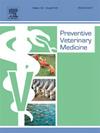改善家养狗和猫的寄生虫诊断:对准确和非侵入性技术的需求
IF 2.4
2区 农林科学
Q1 VETERINARY SCIENCES
引用次数: 0
摘要
由于间歇性的卵子脱落和传统阴道镜技术的局限性,伴侣动物的寄生虫感染构成了一个重大的诊断挑战。本研究旨在以尸检为金标准,评估显微镜和PCR检测狗和猫的囊虫的性能。共有81只动物(46只狗和35只猫)进行了尸检,检查了胃肠道是否有寄生虫。收集粪便标本,采用粪镜检查和PCR方法对寄生虫感染进行分析。尸检发现有7例(8.6 %;95 % CI: 4.3 - 16.8),在81只动物中发现了3只犬双螺旋绦虫(3.7 %;95% % CI: 1.3 - 10.3)的动物(1/46狗;2/35只猫),带绦虫4只(11.4% %;95 % CI: 4.5 - 26.0)。Coproscopy和PCR仅检出2例(5.7% %;95 % CI: 1.6 - 18.6), 3(8.6 %;95 CI: 3.0-22.4)猫。尽管在尸检中发现犬D. caninum,但没有PCR阳性记录。两种方法与尸检的总体一致性中等(coproscopy k = 0.42;PCR k = 0.58),对带绦虫和带绦虫检测具有较高的灵敏度和一致性。这些发现强调了目前的非侵入性诊断方法对绦虫,特别是犬D.的敏感性较差,感染强度与粪便检测之间的相关性有限。该研究提倡迫切需要一种商用的助原抗原检测来提高诊断的准确性。本文章由计算机程序翻译,如有差异,请以英文原文为准。
Improving cestode diagnosis in domestic dogs and cats: the need for accurate and non-invasive techniques
Cestode infections in companion animals pose a significant diagnostic challenge due to intermittent egg shedding and the limitations of traditional coproscopic techniques. This study aimed to evaluate the performance of microscopy and PCR in detecting cestodes in dogs and cats, using necropsy as the gold standard.
A total of 81 animals (46 dogs and 35 cats) were examined by necropsy, with gastrointestinal tracts inspected for cestodes. Fecal samples were collected and analyzed by coproscopy and PCR targeting cestode infections.
Necropsy identified cestodes in 7 (8.6 %; 95 % CI: 4.3 – 16.8) out of 81 animals: Dipylidium caninum was found in 3 (3.7 %; 95 % CI: 1.3 – 10.3) of animals (1/46 dogs; 2/35 cats), and Hydatigera taeniaeformis in 4 (11.4 %; 95 % CI: 4.5 – 26.0) out of 35 cats. Coproscopy and PCR detected only infection with H. taeniaeformis in 2 (5.7 %; 95 % CI: 1.6 – 18.6), and 3 (8.6 %; 95 CI: 3.0–22.4) cats, respectively., No PCR positives were recorded for D. caninum, despite its presence at necropsy. Overall agreement with necropsy was moderate for both methods (coproscopy k = 0.42; PCR k = 0.58), with higher sensitivity and agreement for Taenia spp. and H. taeniaeformis detection. These findings highlight the poor sensitivity of current non-invasive diagnostic methods for cestodes, particularly D. caninum, and the limited correlation between infection intensity and fecal detection. The study advocates for the urgent need for a commercially available coproantigen test to improve the accuracy of diagnosis.
求助全文
通过发布文献求助,成功后即可免费获取论文全文。
去求助
来源期刊

Preventive veterinary medicine
农林科学-兽医学
CiteScore
5.60
自引率
7.70%
发文量
184
审稿时长
3 months
期刊介绍:
Preventive Veterinary Medicine is one of the leading international resources for scientific reports on animal health programs and preventive veterinary medicine. The journal follows the guidelines for standardizing and strengthening the reporting of biomedical research which are available from the CONSORT, MOOSE, PRISMA, REFLECT, STARD, and STROBE statements. The journal focuses on:
Epidemiology of health events relevant to domestic and wild animals;
Economic impacts of epidemic and endemic animal and zoonotic diseases;
Latest methods and approaches in veterinary epidemiology;
Disease and infection control or eradication measures;
The "One Health" concept and the relationships between veterinary medicine, human health, animal-production systems, and the environment;
Development of new techniques in surveillance systems and diagnosis;
Evaluation and control of diseases in animal populations.
 求助内容:
求助内容: 应助结果提醒方式:
应助结果提醒方式:


